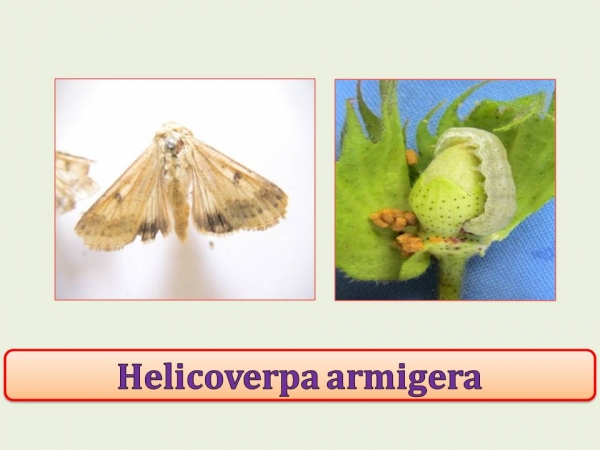
Nature of damage:
-----------------
The young larvae feed on tender leaves and makes small holes on them.
Later on it damage squares, flowers and green bolls.
While feeding the anterior portion of the body remains inside and remaining posterior portion outside the bolls.
Management :
------------
Collection of infested buds, flowers and bolls alongwith larvae and destroy them.
Deep ploughing in summer to expose pupae to solar rays and predatory animals.
Application of NPV (Nuclear Polyhedrosis Virus) Suspension @ 250-500 larval Unit/ha during evening hours.
Biological control : Egg parasite: Trichogramma chilonis, larval parasite: Bracon kirckpetricki, Campoletis chloridii, Chilonis blackburni - 10,000 to 12,000/ha. Predator: Chrysoperla carnea
Chemical measures: Spraying the crop with carbaryl 50% WP 0.20 % @ 3-4 kg/ha or phosalone 35 % EC 0.075% @ 2-2.5 lit./ha or quinalphos 25 % EC 0.05 % @ 2-2.5 lit/ha.
Following dust may be used: carbaryl 10 % dust or phosalone 4 % dust or quinalphos 1.5% dust @ 30-40 kg/ha.
After flowering, apply any one synthetic pyrethroid twice at an interval of 20-25 days. Cypermethrin 10 EC 0.009 % @ 9 ml - 50 gm ai/ha 25 EC 0.009% @ 3-4 ml 50 gm ai/ha deltamethrin 2.8 EC 0.00125 % 4-5 ml - 100 gm ai/ha fenvelrate 20%EC 0.01% @ 5 ml 100 gm ai/ha flucythrinate 10 % EC 0.007% @ 7 ml – 40 gm ai/ha fluvalinate 25% EC 0.009% @ 3-4 ml – 50 gm ai/ha alphamethrin 10% EC 0.0045% @ 4-5 ml – 25 gm ai/ha.

